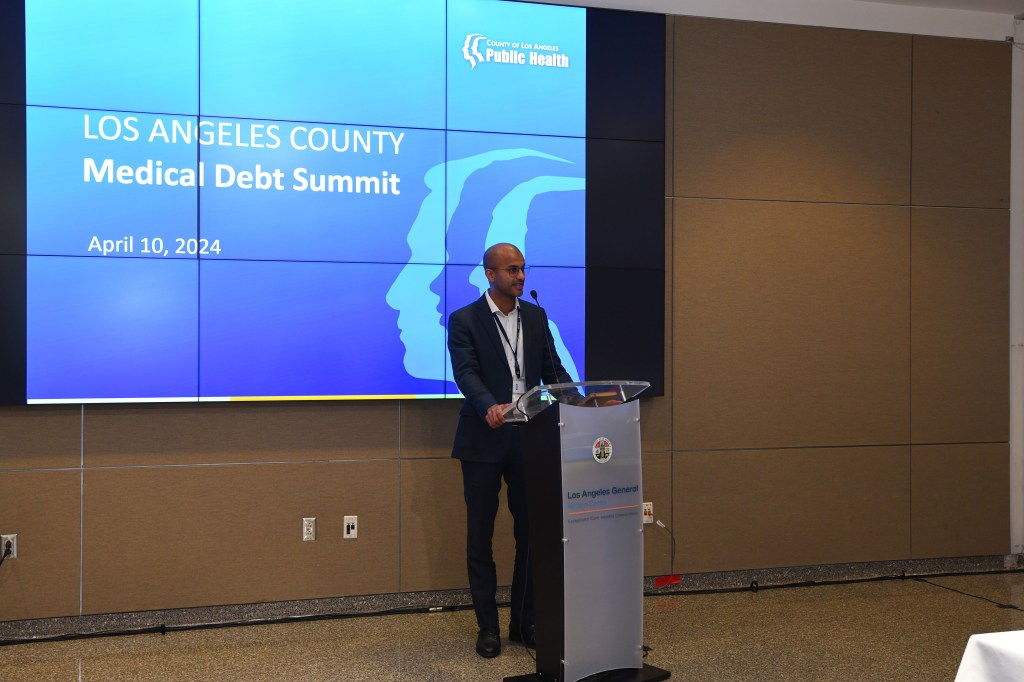Los Angeles County, the nation’s most populous county, is spearheading a comprehensive plan to tackle a $2.9 billion medical debt crisis. Hospitals are still getting on board with the project, which is helmed by the public health department. California, Health Care Costs, Health Care Reform, Health Industry, Public Health, States, Hospitals, Out-Of-Pocket Costs KFF Health News
LOS ANGELES — Los Angeles County has launched one of the most ambitious efforts in the nation to tackle medical debt, targeting hospitals for their role in feeding a $2.9 billion problem.
For over a year, the nation’s most populous county has worked on a comprehensive plan to track patient debt and hospital collection practices; boost bill forgiveness for low-income patients; and buy up and forgive billions in medical debt — an effort helmed by its Department of Public Health.
Though LA County isn’t the first government entity to confront this crisis, what sets it apart is how it casts medical debt not as a political issue, but as an urgent public health threat as prevalent as asthma and diabetes.
“Nobody in the county of LA who is facing economic limitations should have that impact their ability to get the kind of health care, the kinds of services and support that we all need and are essential to optimal well-being,” public health department director Barbara Ferrer said at a medical debt symposium April 10.
Mona Shah of Community Catalyst, a national health equity and policy organization, called the county’s efforts bold — tackling the root causes of medical debt, in addition to providing immediate debt relief, with input and participation from health plans, hospitals, community organizations, and government partners. Shah said the county’s population of about 10 million adds to the significance of its initiative.
But on the eve of the symposium, the local hospital association called on the county to revise its plan.
“We believe the proposed DPH [Department of Public Health] debt relief program and data collection effort will only burden hospitals with unnecessary requirements, without ultimately helping to address the underlying issue,” wrote George Greene, CEO of the Hospital Association of Southern California, in a letter to the LA County Board of Supervisors.
Many of the county’s recommendations would require hospitals to change their processes and add reporting duties. For instance, the county is asking hospitals to inform it when patient debt is sent to collections and pressing hospitals to improve access to financial assistance programs. Although state law requires hospitals to provide assistance, patient advocates say many don’t make it easy for patients to access.
Adena Tessler, LA County regional vice president for the hospital association, told KFF Health News the industry provides ample financial assistance and that the county is putting too much emphasis on hospitals’ role in the debt crisis, when other sectors of the health care system, such as insurers, should share the blame.
Tessler said the county plan should include all players, including health plans, provider groups, and ambulance providers.
“Medical debt is a problem, and we want to be a part of the solution,” Tessler said. “But hospitals are not the only source of medical debt.”
Medical debt affects 4 in 10 adults in the U.S., according to a KFF Health News analysis. LA County found, in its own analysis this year, that about 785,000 residents were burdened in 2022 with a total of $2.9 billion in medical debt.
The county analysis shows that medical debt disproportionately affects people of color, low-income people, and families with children. Having medical debt more than doubled the likelihood that patients would delay or forgo health care or prescriptions or be at risk of losing housing or going hungry.
Nationally, a handful of states have passed rules to limit medical debt collection or bolster hospital financial assistance policies. Some jurisdictions have relieved residents of debt. Connecticut, Colorado, and New York enacted laws in the last two years to ban medical debt on credit reports, which can depress credit scores and make it harder for patients to get a job, rent an apartment, or secure a car loan. California lawmakers have proposed similar legislation, and the federal Consumer Financial Protection Bureau is also developing a set of rules.
“It’s a huge public health problem,” said Naman Shah, medical and dental affairs director at the public health department. “We in public health try to shift the determinants of health. Those are things that impact health deeply and impact people widely. Medical debt fulfills both of those. It’s important that we see this as a health issue, and not just a regulatory issue.”
The department made initial recommendations last spring, then further developed them with the backing of the Board of Supervisors, which described medical debt as “pervasive” and “causing financial, mental, and physical harm … especially to those from historically marginalized communities.”
Shah said that while the department continues to take hospital input and has addressed some of the association’s “misunderstandings,” officials are moving ahead with the plan. Tessler agreed the focus is on collaboration, not halting the county plan.
Over the next several months, the county plans to score hospitals based on financial assistance accessibility and provide them with templates and guidelines to make financial assistance less confusing and less burdensome for patients.
States such as Washington, Oregon, and Maryland have developed similar materials for hospitals.
The county’s goals also call for other debt prevention strategies, including working with plans and providers to better educate consumers to avoid surprise billing and out-of-network charges.
Shah said he was surprised by the timing of the hospital association’s letter, especially since county officials and hospital representatives met several times before the April symposium. He agreed it is important to tackle all sources of medical debt but said hospitals are a reasonable place to start. Nearly 75% of adults with medical debt owe some or all of it to hospitals, according to a 2023 Urban Institute analysis.
“We want to get the most bang for our buck,” Shah said. “The largest bill that a patient receives is not a dental bill. It’s not an office bill. It’s a hospital bill.”
This article was produced by KFF Health News, which publishes California Healthline, an editorially independent service of the California Health Care Foundation.
KFF Health News is a national newsroom that produces in-depth journalism about health issues and is one of the core operating programs at KFF—an independent source of health policy research, polling, and journalism. Learn more about KFF.
USE OUR CONTENT
This story can be republished for free (details).









